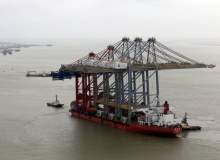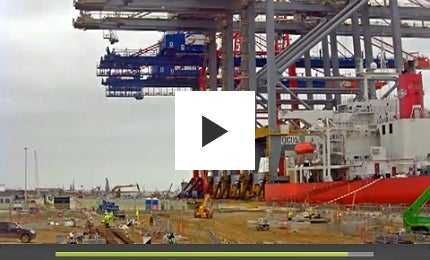
At the end of February 2013, three behemoths sailed into the UK’s Thames Estuary after a two-month voyage from the other side of the world. They eventually came to rest at London Gateway, DP World‘s mega-port and logistics park currently being constructed in Thurrock, Essex. The giants in question are the colossal new cranes that have just been delivered to London Gateway from China by Shanghai Zhenhua Heavy Industries Company, which also built the huge structures.
To put the sheer size of these 138m cranes into context, each one weighs around 2,000 tonnes and stands taller than the London Eye. Conventional cranes of this type can typically handle two standard containers at a time, but these mechanical monsters will be able to simultaneously lift four containers, helping London Gateway reach its target capacity of 3.5 million twenty foot equivalent units (TEU) at some point after first-stage completion, which is expected in the last quarter of 2013.
Installing London Gateway’s giant cranes
“London Gateway port, and the combined logistics park, is Britain’s new gateway for global trade,” said DP World London Gateway CEO Simon Moore at the beginning of March.
“These cranes will bring new innovation and efficiency to the supply chain industry,” Moore continued. “It won’t be long before importers and exporters across the country will be able to cut costs dramatically from their supply chains by choosing London Gateway, a port which is much closer to where goods need to go. A world-class deep-sea container port requires a world-class set of cranes. They will be the lynchpin of the operation – the biggest, most modern and most efficient the UK has ever seen.”
How well do you really know your competitors?
Access the most comprehensive Company Profiles on the market, powered by GlobalData. Save hours of research. Gain competitive edge.

Thank you!
Your download email will arrive shortly
Not ready to buy yet? Download a free sample
We are confident about the unique quality of our Company Profiles. However, we want you to make the most beneficial decision for your business, so we offer a free sample that you can download by submitting the below form
By GlobalDataInchcape Shipping Services (ISS) acted as the agent for the cranes upon their arrival at the port. The maritime services company took responsibility for clearing the ship carrying the cranes, the Zhen Hua 26, through UK customs and the central European reporting system for customs clearance.
But the company’s biggest job was to supervise and co-ordinate the incredibly complex process of bringing the Zhen Hua 26 into position at the berth and discharging the cranes. The cranes were far too large and heavy for another crane to be capable of lifting them, so project engineers got the cranes onto the dock using a system of pulleys, weights and rollers that harks back to ancient Egyptian engineering techniques.
“It will take us a whole week to unload them,” DP World spokesman Tom Conroy told the Lloyd’s Loading List at the time. “You could say we are using the most ancient techniques to accommodate the most modern, robotic technology.”
Two more cranes are currently en-route from China, having set sail at the end of February, and should arrive in the next few weeks. This initial set of five cranes will eventually be joined by 19 more over the coming years. The cranes will ultimately operate on a new 2.7km quay wall, the foundations of which delve around 50m under the ground.
London Gateway: the UK’s future-proofed container port
DP World is sparing no expense to ensure that the port becomes the UK’s primary modern deep sea container facility, after gaining ownership of the London Gateway plan as part of its £3.92bn acquisition of P&O in 2006. The marine terminal operator is investing around £1.5bn into the development of the port and associated facilities, and sees London Gateway as a container hub that will remain globally competitive and technologically state-of-the-art for the foreseeable future.
The port itself will feature the aforementioned quay wall, with 24 cranes and six berths. The shipping channel has been dredged from 11m to 14.5m in the inner channel, with the outer channel dredged to 16m. The berth pockets have also been deepened to 17m, allowing the port to accommodate the world’s largest container ships. Much of the dredged material has been reused, to create new land on which to build the terminal.
The port will also be integrated with Europe’s largest logistics park, a move that is intended to improve efficiency and give cargo companies better access to the lucrative consumer market of London and the south-east of England. The park will provide some 860,000m² of cargo accommodation for distribution companies, and DP World is working on upgrading the site’s transport connections. Millions of pounds are being poured into local roads like the A13 and the M25 motorway, and with 20km of new track under construction to improve the site’s rail freight connections, up to 30% of the cargo rolling out from the park should be on rails rather than wheels.
Related content
Video feature: solar energy powers new eco-friendly ship design
With its Aquarius MRE system, Eco Marine Power is planning to help large vessels tap into solar and wind power to reduce their emissions and fuel consumption.
Video feature: The New Port Project: Qatar’s marine megaproject
Qatar’s $7.4bn New Port Project is a greenfield development on the largest scale, transforming an empty stretch of sand into a cutting-edge commercial port.








